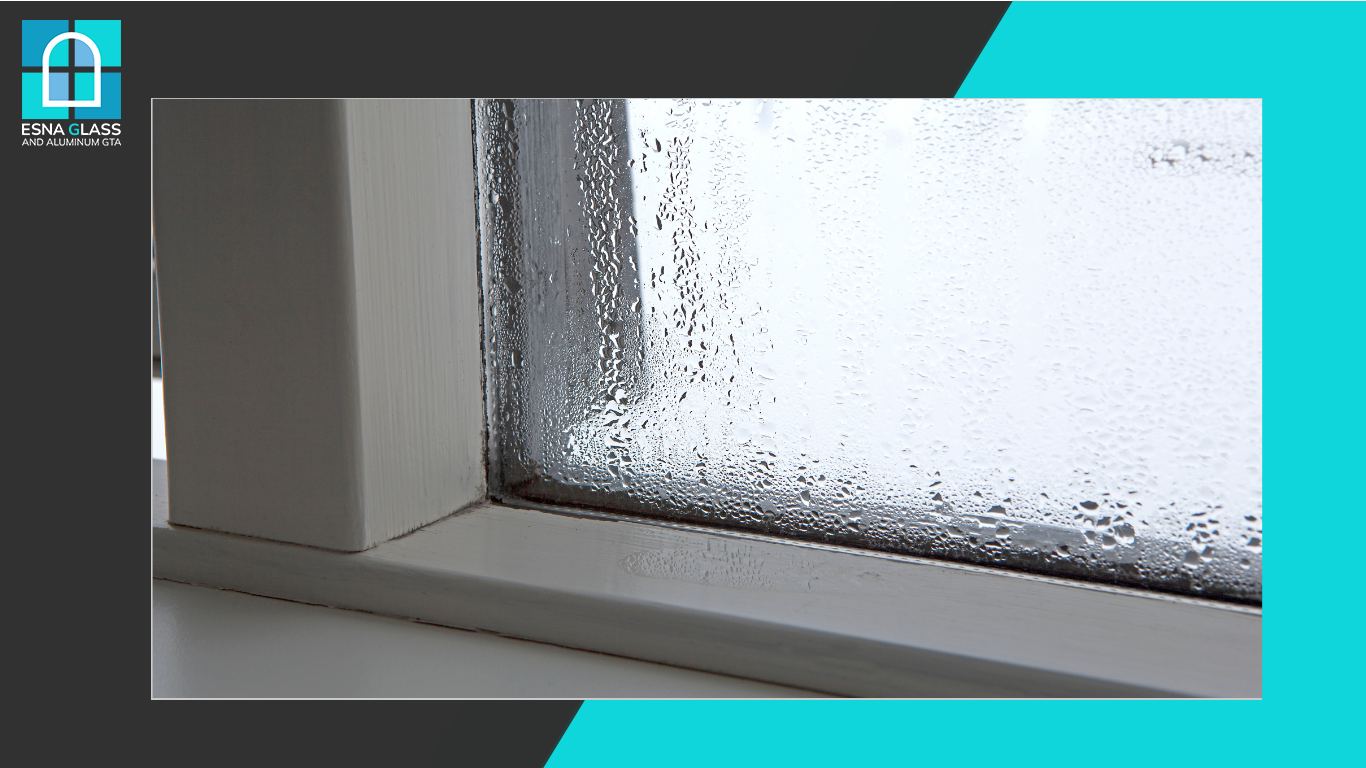Condensation occurs when a high level of humidity meets the colder surface. This causes moisture in the air, which is warmer, to condense into water droplets on the colder surfaces, such as windows, outside walls, and mirrors.
Now, consider times when, after taking a hot shower, the steam escapes the shower, and when meeting cold surfaces like walls, mirrors, or windows, it condenses, resulting in excessive moisture on these surfaces. Fortunately, the condensation will eventually dissipate, and if you want to use the mirror immediately, you can simply wipe off the moisture. However, condensation between window panes can lead to problems, and if not addressed properly, it can create a perfect condition for mold growth.
Condensation Between Window Panes: Why It Occurs?
Typically, condensation occurs when warm moisture in the air meets cold surfaces. When the warm moisture collides with the cold glass, it turns into moisture droplets. If the seal around the window’s perimeter has deteriorated, moisture droplets can find their own way between the window panes.
The Reason for Moisture Between Window Panes
In fact, condensation isn’t a significant issue, and it’s a normal event, but if it happens between window panes, it can lead to complications.
Typically, condensation between window panes is classified into two groups: exterior and interior window condensation. Let’s delve into the details.
Exterior window condensation
Exterior window condensation occurs when there’s a high level of humidity outside and the temperature reaches the dew point. The dew point is the temperature at which the air can no longer hold all of its water vapor, causing it to become saturated. When the temperature is below the dew point, the rate of condensation is higher than that of evaporation, leading to more water droplets.
Exterior window condensation is commonly observed during the morning or in shaded areas where the temperature of window surfaces is lower than the surrounding air. It’s generally not an issue and doesn’t need any special attention.

Interior window condensation
The reason for interior window condensation is the same as mentioned above. However, condensation on the inside of the window can be problematic.
Based on the Environment Protection Agency (EPA), the ideal humidity level for homes should range from 30% to 60%. During the winter, it’s recommended to keep the humidity closer to 30%, while in hot seasons, maintaining a humidity level between 50% and 60% is ideal.
You can check your home’s humidity level using a humidity meter; most current thermostats have a built-in humidity meter, but if you don’t have, you can order one online.
High levels of humidity in the home can cause problems as they create a perfect environment for mold or mildew growth, which may not be visible. Mold can grow behind walls, in any crawl spaces, or even in ceilings.
If condensation occurs only occasionally, for example, in your bathroom when taking a shower, it’s probably not a significant issue. However, if window condensation happens regularly in a particular room or on all windows, it can lead to a big issue.
Condensation between window panes
Double-glazed windows, insulated glass units (IGUs), triple-pane windows, and thermopane windows are all different terms used to describe modern windows that offer improved insulation properties. In contrast to single-pane windows, these types of windows consist of two or more glass sheets spaced to a particular width with air or gas in between to provide enhanced insulation benefits.
Double-pane windows are twice as effective as single-windows at keeping heat in during the winter and cooling air during the summer.
They are typically sealed during the manufacturing process to prevent outside moisture from entering between the panes and provide enhanced insulation. A desiccant, which is a substance that absorbs moisture, is usually used between the panes to keep the spaces between the panes dry. Sometimes, manufacturers use argon or krypton gas to fill the spaces for better insulation.
If the seal around the panes fails, the fresh air, containing the moisture, finds its own way into the space between the panes, where it condenses. This could lead to a milky appearance on the inside of the window.

How to remove moisture from between window panes?
Below, we describe the process of removing condensation from a double window pane. Before reading the continuation, please note that not all windows are good candidates for this procedure, for example, tempered glass windows.
Step 1. Drill holes.
Window repair professionals drill small holes in the outside of window panes to release the tapped moisture between the panes.
Step 2. Release air.
Professional window repairs use some appropriate devices to stick out the air and moisture between the glass panes. Chemicals are pushed into a small hole that was drilled in step 1, and then released through the other hole, leaving the inside of the glass pane clean and free from condensation.
Step 3. Lessen future moisture collection
At this point, leave the window as it is, but it’s likely that moisture will collect again at the same point. The hole should be sealed to prevent the outside moisture from reentering the space.
Another option to release moist air is to use one-way air vents to keep condensation from forming while still preventing new outside air from entering the space.
However, none of these solutions are long-term and won’t compensate for the energy loss caused by the escaped gas buffer between the panes.
How to prevent condensation between window panes?
There are several steps to tackle moisture between panes:
Upgrade to double glazing: Generally speaking, single-glazed windows are more prone to condensation than double-glazed, as the glass cannot warm along with the room temperature, remaining as cold as the outside environment. However, the inner glass pan will be significantly warmer.
Consider a dehumidifier: Dehumidifiers help get rid of condensation by removing excessive moisture from the air.
Upgrade insulation: If your home has inadequate insulation, it’s probably cold and more susceptible to condensation. Enhancing your home’s insulation can help you overcome this problem.
Improve ventilation: Enhancing your home ventilation can significantly address the problem. Even opening the windows or installing trickle vents can make a noticeable difference. Additionally, wall vents or air bricks can be beneficial, and in areas like bathrooms or kitchens, installing suitable extractor fans can help alleviate the issue.
Heat the room: Maintaining a slightly elevated room’s temperature and keeping it stable can be helpful to mitigate the condensation issue, as the air retains the moisture more effectively, reducing the likelihood of condensation and deposing on the window.
Consider Positive Input Ventilation: Retrofitting Positive Input Ventilation (PIV) is easier than installing mechanical ventilation with heat recovery (MVHR). PIV units operate by pumping and circulating filtered, fresh air into the house, effectively displacing stale or humid air.
Lower Humidity Levels: Reducing humidity levels in your home can be achieved through various methods. Consider drying clothes outdoors or opening windows in rooms where wet clothes are hanging. Installing extractor fans and ensuring ventilation in bathrooms by opening windows or doors can also aid in dispersing humidity.
Bottom Line
If you need a professional glass repair, call us at Esna. We are an experienced team that is available 24/7 to help and address all your needs and concerns.
FAQ
How do you fix moisture between panes?
Here are some ways to mitigate the moisture between the window panes:
- Use a hair dryer on a cool setting to evaporate the moisture. Move the hair dryer around the window until the moisture dissipates. Afterwards, apply sealant to reseal the window and prevent new moisture from forming.
- Use a dehumidifier to reduce the moisture in the air and prevent more condensation from forming. If condensation has already formed, use a vacuum cleaner with a small attachment to suck up the moisture.
- Drill two small holes in the exterior bottom of glass. When exposed to the sun, these holes will allow trapped moisture to escape. After dissipating the moisture, plug the holes to restore the window’s integrity.
What causes condensation between window panes?
Condensation between the window panes can be caused by:
- A broken seal around the glass’s perimeter allows moisture to find its own way between the glass panes.
- Direct exposure to sunlight causes the glass to expand, contract, and eventually weaken.
- Temperature differentials are most significant during sharp fluctuations or rapid changes in temperature.
- During the early stages of the heating season, there is an increased circulation of fresh moisture throughout the property, leading to higher chances of temperature differentials.
- An excessive difference in temperature between the outside and inside of the windows.
- Increased the level of steam inside of the home, caused by activities like doing laundry, showering, or cooking.
Is moisture between window panes bad?
Yes, because it often indicates a failed window seal on double or triple window panes. When the seal fails, outside air and moisture can enter, leading to condensation and reduced thermal efficiency.




